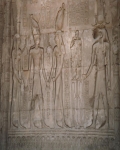EsnaTemple
Archaeology »
Archaeological Monuments » EsnaTemple
EsnaTemple - Egypt
EsnaTemple is located in Luxor,Esna.
EsnaTemple monument was established on 18th Century.
Primary threats to EsnaTemple :
Esna Temple would once have been built to a plan similar to the temples at Edfu and Dendera but all that now remains is the hypostyle hall which was built by the Roman Emperor Claudius who extended earlier buildings.
Historical facts of EsnaTemple :
- The Esna Temple, also known as the Temple of Khnum, is an ancient Egyptian temple located in the city of Esna, which was known as "Latopolis" in ancient times. It is one of the most well-preserved temples in Egypt and holds great historical significance. Here are some key historical facts about the Esna Temple.
- Origins: The construction of the Esna Temple dates back to the Ptolemaic period, specifically during the reign of Ptolemy VI Philometor (180-145 BCE). However, the site itself has a much longer history, as it was built on the remains of earlier temples that existed during the Old Kingdom and the New Kingdom.
- Dedicated to Khnum : The main deity worshiped at the Esna Temple is Khnum, an ancient Egyptian god associated with creation and fertility. Khnum was believed to have fashioned the bodies of human beings on a potter's wheel, shaping them from clay. The temple was built to honor Khnum and to seek his blessings.
- Architectural Style : The Esna Temple follows the typical layout of Egyptian temples, with a large pylon (gateway), a courtyard, hypostyle halls, and a sanctuary. The temple's walls are adorned with intricate carvings and inscriptions depicting various scenes from Egyptian mythology, religious rituals, and daily life.
- Christian Conversion : During the early Christian period, the Esna Temple was converted into a church. The conversion involved covering the temple's intricate reliefs with plaster to create a blank surface for Christian paintings. These Christian additions were later removed, revealing the original ancient Egyptian artwork.
- Unfinished Decoration : One notable feature of the Esna Temple is that some of its chambers were left unfinished. The reason for this remains uncertain, but it is speculated that the construction might have been halted due to political or economic reasons. The unfinished sections offer valuable insights into the temple's construction techniques.
- Zodiac Ceiling : One of the most famous features of the Esna Temple is its zodiac ceiling. Located in the hypostyle hall, the ceiling depicts a celestial chart featuring zodiac signs and astronomical symbols. This remarkable ceiling has attracted the attention of scholars and has been the subject of much study and interpretation.
- Rediscovery and Restoration : The Esna Temple was buried under debris and silt for centuries until it was rediscovered in the 19th century. Excavation and restoration works were carried out to uncover and preserve the temple's magnificent architecture and artwork. The restoration efforts continue to this day, ensuring the temple's longevity for future generations.
- Importance as a Cultural Heritage Site : The Esna Temple provides valuable insights into ancient Egyptian religion, art, and architecture. It serves as a testament to the rich cultural heritage of Egypt and attracts tourists and scholars from around the world. The temple's well-preserved state allows visitors to experience the grandeur and beauty of ancient Egyptian temples.
- Temples of Esna Festival : The city of Esna celebrates its historical heritage with an annual festival known as the "Temples of Esna Festival." This event showcases the cultural traditions of the region, including music, dance, and theatrical performances. The festival also highlights the importance of preserving and promoting the Esna Temple.
- Modern Threats : Despite ongoing restoration efforts, the Esna Temple faces modern challenges such as urban encroachment and environmental factors. Pollution and rising groundwater levels pose risks to the temple's stability and the preservation of its delicate artwork. Conservation initiatives are essential to safeguard this historical treasure for future generations.
- In conclusion, the Esna Temple is a remarkable ancient Egyptian temple that provides valuable insights into the civilization's religion, art, and architecture. Its well-preserved state, unique features, and ongoing restoration efforts make it an important cultural heritage site. The temple's historical significance and architectural beauty continue to captivate visitors and researchers alike, ensuring its place as a remarkable testament to ancient Egyptian civilization.

